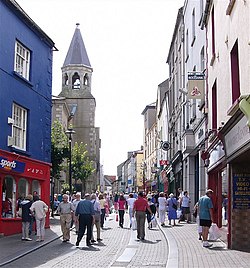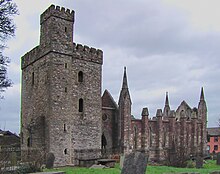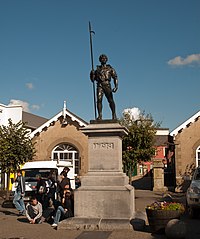Wexford
| Wexford Irish: Loch Garman | |
| County Wexford | |
|---|---|
 Main Street, Wexford | |
| Location | |
| Grid reference: | T051213 |
| Location: | 52°20’3"N, 6°27’27"W |
| Data | |
| Population: | 19,913 (2011) |
| Dialling code: | 053 |
| Local Government | |
| Dáil constituency: |
Wexford |
| Website: | http://www.wexfordcorp.ie |
Wexford is the county town of County Wexford. It is a port town in the very south-east of Ireland. It is an ancient town, founded by Scandinavian settlers in the Viking Age.
The town is on a sheltered bay, very close is near the south-eastern corner of Ireland, close to Rosslare Europort, which has taken over as Wexford's main port.
The town is linked to Dublin by the M11/N11 National Primary Route, and the national rail network. It has a population of 19,913 (20,072 with Environs) according to the 2011 census.
Name
The name 'Wexford' is from the Old Norse Veisafjǫrðr, meaning "mud flats fjord". In the old local dialect, known as Yola, it is Weisforthe,[1] which is very close to the Norse.
In the Irish language the town is known as Loch Garman.
History

Wexford lies on the south side of Wexford Harbour, the estuary of the River Slaney. According to a local legend, the town got its Irish name, Loch Garman, from a young man named Garman Garbh who was drowned on the mudflats at the mouth of the River Slaney by flood waters released by an enchantress. The resulting lough was thus named, Loch Garman.
The town was founded by the Vikings in about 800 AD. They named it Veisafjǫrðr and the name has changed only slightly into its present form. For about three hundred years it was a Viking town, a city state, largely independent and owing only token dues to the Irish kings of Leinster. The Norse kingdom survived until the Norman-English conquest of Ireland.
In May 1169, Wexford was besieged by Dermot MacMurrough, King of Leinster and his Norman ally, Robert Fitz-Stephen. The Norse inhabitants resisted fiercely, until the Bishop of Ferns persuaded them to accept a settlement with Dermot.
Wexford was an English settlement in the Middle Ages. An old dialect of English known as Yola was spoken uniquely in Wexford up until the 19th century.
Notwithstanding its habitation by Englishmen or their descendants, County Wexford produced strong support for Confederate Ireland during the 1640s. A fleet of Confederate privateers was based in Wexford town, consisting of sailors from Flanders and Spain as well as local men. Their vessels raided English Parliamentarian shipping, giving some of the proceeds to the Confederate government in Kilkenny. As a result, the town was sacked by the English Parliamentarians during the Cromwellian conquest of Ireland in 1649. Many of its inhabitants were killed and much of the town was burned.

County Wexford was the centre of the 1798 rebellion. Wexford town was held by the rebels throughout the fighting and was the scene of a notorious massacre of local loyalists by the United Irishmen, who executed them with pikes on Wexford bridge.
Wexford's success as a seaport declined in the 20th century, because of the constantly changing sands of Wexford Harbour. By 1968 it had become unprofitable to keep dredging a channel from the harbour mouth to the quays in order to accommodate the larger ships of the era, so the port closed. The port had been extremely important to the local economy, with coal being a major import and agricultural machinery and grain being exported. The port is now used exclusively by mussel dredgers and pleasure craft. The woodenworks which fronted the quays and which were synonymous with Wexford were removed in the 1990s as part of an ambitious plan to claim the quay as an amenity for the town as well as retaining it as a commercially viable waterfront. Despite the bankruptcy of the contractor, the project was a success.
In the early 20th century, a new port was built, about 12 miles south, at Rosslare Harbour, now known as Rosslare Europort. This is a deepwater harbour unaffected by tides and currents. All major shipping now uses this port and Wexford Port is used only by fishing boats and leisure vessels.

Culture
Wexford is the home of many youth and senior theatre groups including the Buí Bolg street performance group, Oyster Lane Theatre Group, Wexford Pantomime Society, Wexford Light Opera Society and Wexford Drama Group.
Wexford has a number of music and drama venues including Wexford Opera House, the Dun Mhuire Theatre and Wexford Arts Centre. Wexford's Theatre Royal opera house was recently replaced by the Wexford Opera House and it hosts the internationally recognised Opera Festival every October. Dr Tom Walsh started the festival in 1951, and it has since grown into the internationally recognised festival it is today. The Dun Mhuire Theatre holds music events and bingo as well as hosting shows by Oyster Lane Theatre Group and Wexford Pantomime Society. The Wexford Arts Centre hosts exhibitions, theatre, music and dance events. Various concerts are held in St Iberius's Church (Church of Ireland).
Until the mid-nineteenth century the Yola language could be heard in Wexford, and a few words still remain in use. The food of Wexford is also distinct from the rest of Ireland, due to the local cultivation of seafood, smoked cod being a token dish in the region.
Architecture
Wexford has witnessed some major developments such as the Key West centre on the Quays, the redevelopment of the quayfront itself, White's Hotel and the huge new residential development of Clonard village. Proposed developments include the development of a large new residential quarter at Carcur, a new river crossing at that point, the new town library, the refurbishment of Selskar Abbey and the controversial redevelopment of the former site of Wexford Electronix.
Notable churches within the town include St Iberius, Bride Street and Rowe Street with their distinctive spires, the impressive Saint Peter's College, with a chapel designed by Pugin and Ann Street Presbyterian church. A former Quaker meeting hall is now a band room in High Street.
Two of the most noticeable buildings in Wexford are the "Twin Churches" Rowe Street and Bride Street These churches can be seen from any part of Wexford and in 2008 celebrated their 150th anniversary; a huge event for the churches.
Places of Interest
Curracloe Beach in Wexford was the location in 1997 for the opening scenes of Saving Private Ryan.[2]
The Irish National Heritage Park at Ferrycarrig includes various exhibits spanning 9000 years of Irish History, allowing the visitor to wander around re-creations of historic Irish dwelling including crannogs, Viking houses and Norman forts.[3]
The Wexford Wildfowl Reserve is a Ramsar site based on mudflats, (known locally as slobland), just outside Wexford.[4] It is a migratory stop-off point for thousands of ducks, geese, swans and waders. Up to 12,000 (50% of the world's population) of Greenland White-fronted Geese spend the winter on the Wexford slobs. There is a visitor centre with exhibitions and an audio-visual show.[5]
Sport
- Golf: Wexford Golf Club
- Football: Wexford Youths
- Gaelic games: several Gaelic Athletic Association clubs. Though the town was traditionally associated with Gaelic football and it wasn't until 1960 that hurling took its foothold
- Rugby: Wexford Wanderers.
Outside links
| ("Wikimedia Commons" has material about Wexford) |
- County Wexford Web Portal
- Wexford Tourism Website
- Wexford Means Business Website
- KilmoreGenealogy.com, Hidden Wexford Genealogy, a genealogy website devoted to those researching Wexford institutions
- Wexford GAA.ie
- WexfordWeb.com, The Web Portal for Wexford
- Anglican.org, Wexford Union and Kilscoran Union, Church of Ireland
- Wexford County Council (Local Government)
- Wexford Harbour Resource Website (weather,navigation, tide, history)
References
- ↑ Latham, Robert Gordon: The English Language: Volume 1. Walton and Maberly, 1855. Page 426-427.
- ↑ "Saving Private Ryan". Filmography. The Irish Film and Television Network. http://www.iftn.ie/locations/sublinks_static/wexford/?act1=record&aid=70&rid=1493&tpl=filmography_dets&only=1&force=1. Retrieved 4 April 2011.
- ↑ "The Park". The Irish National Park. http://www.inhp.com/park-history/. Retrieved 13 December 2012.
- ↑ "Wexford Wildfowl Reserve - About Us". National Parks & Wildlife Service. http://www.wexfordwildfowlreserve.ie/about.html. Retrieved 13 December 2012.
- ↑ "The Wexford Wildfowl Reserve". Office of Public Works (OPW). http://www.heritageireland.ie/en/South-East/TheWexfordWildfowlReserve/. Retrieved 13 December 2012.
- Billy Colfer (20 April 2008). Wexford: A Town and Its Landscape. Cork University Press. ISBN 1-85918-429-4.
